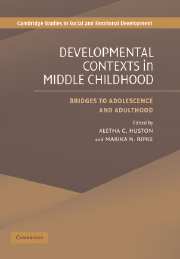Book contents
- Frontmatter
- Contents
- Contributors
- Foreword
- Acknowledgments
- 1 Middle Childhood: Contexts of Development
- 2 The Significance of Middle Childhood Peer Competence for Work and Relationships in Early Adulthood
- 3 Aggression and Insecurity in Late Adolescent Romantic Relationships: Antecedents and Developmental Pathways
- 4 Middle Childhood Family-Contextual and Personal Factors as Predictors of Adult Outcomes
- 5 Genetic and Environmental Influences on Continuity and Change in Reading Achievement in the Colorado Adoption Project
- 6 Reciprocal Effects of Mothers' Depression and Children's Problem Behaviors from Middle Childhood to Early Adolescence
- 7 Middle Childhood Life Course Trajectories: Links Between Family Dysfunction and Children's Behavioral Development
- 8 The Contribution of Middle Childhood Contexts to Adolescent Achievement and Behavior
- 9 Educational Tracking Within and Between Schools: From First Grade Through Middle School and Beyond
- 10 School Environments and the Diverging Pathways of Students Living in Poverty
- 11 The Relations of Classroom Contexts in the Early Elementary Years to Children's Classroom and Social Behavior
- 12 Out-of-School Time Use During Middle Childhood in a Low-Income Sample: Do Combinations of Activities Affect Achievement and Behavior?
- 13 Low-Income Children's Activity Participation as a Predictor of Psychosocial and Academic Outcomes in Middle Childhood and Adolescence
- 14 Healthy Mind, Healthy Habits: The Influence of Activity Involvement in Middle Childhood
- 15 Media Effects in Middle Childhood
- 16 Continuity and Discontinuity in Middle Childhood: Implications for Adult Outcomes in the UK 1970 Birth Cohort
- 17 Mandatory Welfare-to-Work Programs and Preschool-Age Children: Do Impacts Persist into Middle Childhood?
- 18 Effects of Welfare and Employment Policies on Middle-Childhood School Performance: Do They Vary by Race/Ethnicity and, If So, Why?
- 19 Effects of a Family Poverty Intervention Program Last from Middle Childhood to Adolescence
- 20 Experiences in Middle Childhood and Children's Development: A Summary and Integration of Research
- Author Index
- Subject Index
- References
1 - Middle Childhood: Contexts of Development
Published online by Cambridge University Press: 16 September 2009
- Frontmatter
- Contents
- Contributors
- Foreword
- Acknowledgments
- 1 Middle Childhood: Contexts of Development
- 2 The Significance of Middle Childhood Peer Competence for Work and Relationships in Early Adulthood
- 3 Aggression and Insecurity in Late Adolescent Romantic Relationships: Antecedents and Developmental Pathways
- 4 Middle Childhood Family-Contextual and Personal Factors as Predictors of Adult Outcomes
- 5 Genetic and Environmental Influences on Continuity and Change in Reading Achievement in the Colorado Adoption Project
- 6 Reciprocal Effects of Mothers' Depression and Children's Problem Behaviors from Middle Childhood to Early Adolescence
- 7 Middle Childhood Life Course Trajectories: Links Between Family Dysfunction and Children's Behavioral Development
- 8 The Contribution of Middle Childhood Contexts to Adolescent Achievement and Behavior
- 9 Educational Tracking Within and Between Schools: From First Grade Through Middle School and Beyond
- 10 School Environments and the Diverging Pathways of Students Living in Poverty
- 11 The Relations of Classroom Contexts in the Early Elementary Years to Children's Classroom and Social Behavior
- 12 Out-of-School Time Use During Middle Childhood in a Low-Income Sample: Do Combinations of Activities Affect Achievement and Behavior?
- 13 Low-Income Children's Activity Participation as a Predictor of Psychosocial and Academic Outcomes in Middle Childhood and Adolescence
- 14 Healthy Mind, Healthy Habits: The Influence of Activity Involvement in Middle Childhood
- 15 Media Effects in Middle Childhood
- 16 Continuity and Discontinuity in Middle Childhood: Implications for Adult Outcomes in the UK 1970 Birth Cohort
- 17 Mandatory Welfare-to-Work Programs and Preschool-Age Children: Do Impacts Persist into Middle Childhood?
- 18 Effects of Welfare and Employment Policies on Middle-Childhood School Performance: Do They Vary by Race/Ethnicity and, If So, Why?
- 19 Effects of a Family Poverty Intervention Program Last from Middle Childhood to Adolescence
- 20 Experiences in Middle Childhood and Children's Development: A Summary and Integration of Research
- Author Index
- Subject Index
- References
Summary
In 1981, the National Research Council organized the expert Panel to Review the Status of Basic Research on School-Age Children, which produced a seminal volume, Development During Middle Childhood: The Years From Six to Twelve (Collins, 1984). The panel concluded that middle childhood is a time of marked change in capacities and typical behaviors that have long-term implications for adolescent and adult patterns. Although several chapters dealt with family, school, peer, and cultural influences on development, most of the research reviewed was designed to understand normative developmental patterns rather than individual differences. The panel noted gaps in available knowledge about what characteristics of middle childhood environments influence developmental change and about the range of environments experienced by children in the different “ecocultural niches” that are defined by such characteristics as ethnic group, socioeconomic characteristics, family structure, and geographic location (Weisner, 1984). Because “Middle childhood behavior and performance have repeatedly been found to predict adolescent and adult status … more reliably than do early childhood indicators,” the panel recommended additional research on the processes by which middle childhood contributes to later development (Collins, 1984, p. 409).
WHAT DOES MIDDLE CHILDHOOD EXPERIENCE CONTRIBUTE?
In 1994, the MacArthur Foundation formed a Research Network on Successful Pathways Through Middle Childhood, comprising an interdisciplinary group of scholars, with the goal of advancing knowledge about this age group. One of the network's activities involved gathering a group of investigators to analyze longitudinal studies around a common set of questions about middle childhood.
- Type
- Chapter
- Information
- Developmental Contexts in Middle ChildhoodBridges to Adolescence and Adulthood, pp. 1 - 22Publisher: Cambridge University PressPrint publication year: 2006
References
- 23
- Cited by



